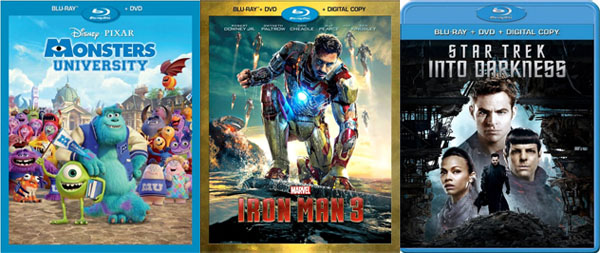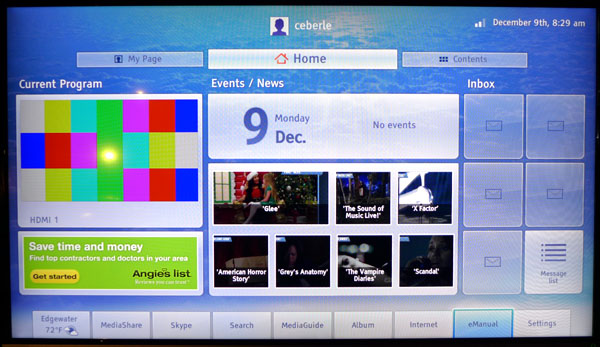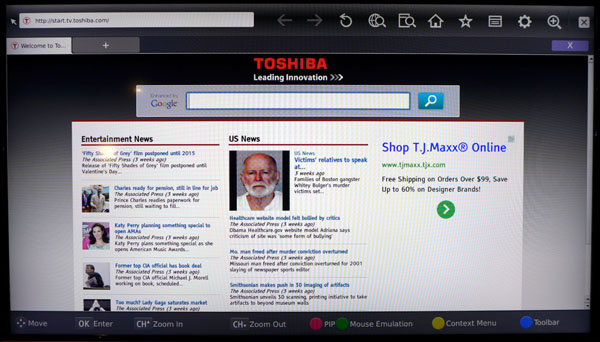Toshiba 50L7300U Review: A 50-Inch LED HDTV With Wi-Fi
You've seen us dramatically increase our display coverage over the last year, and now we're reviewing HDTVs too. Our first screen is Toshiba’s 50-inch L7300U Cloud TV with Wi-Fi. We run it through our lab and usability tests to see how it measures up.
The Toshiba 50L7300U In Use
To put the 50L7300U through its paces with real-world content, we connected an Oppo BDP-93 Blu-ray player and spun a few discs, giving us a chance to evaluate its picture and audio quality. We made one discovery right away: the TV does not accept DTS bitstreams; only Dolby Digital and LPCM work. The best bet is to set your source to output LPCM for everything. Since, most Blu-rays are encoded with DTS-HD Master Audio soundtracks, you won’t hear them unless you convert to PCM first.
Movies
First, we checked out the latest Pixar film Monsters University. It is true that CGI content makes nearly any display look good, but Pixar goes beyond other animated filmmakers when it comes to fine detail and texture. Our favorite example is the flowing blue and purple hair on the Sully character. The 50L7300U displays every strand without jagged artifacts or edge enhancement. Wall textures also stand out, in particular. It takes a display with accurate gamma and solid contrast to capture fine color gradations like this, and the Toshiba excels.
Next we put in Iron Man 3. There is plenty of rich saturated color in this transfer and the 50L7300U shows it all without looking overblown or cartoonish. We really like the quality of fleshtones in close-up shots of Gwyneth Paltrow and Robert Downey, Jr. During one dark sequence, when Tony Stark crash-lands in a small remote town, we decided to try the DynaLight and Dynamic Contrast features. Leaving Dynamic Contrast on Low works reasonably well. There is no clipping of shadow detail, but we could see the image brightness pump a little as the scene’s content changed. This is one potential side effect of any kind of dynamic contrast option. The TV has excellent contrast without it, so we left it off for the rest of our evaluation.
Our final film was Star Trek Into Darkness. Both this and its predecessor are filled with high-contrast and saturated color. The opening scene that takes place on an alien planet looks excellent. Despite all the vegetation being an almost-searing red color, there is no lack of detail. Many displays would show colored blobs instead of finely-textured vines and plants. Director J.J. Abrams is fond of tremendous contrast in all his material. Whether the content is dark or extremely bright, the 50L7300U renders every scene beautifully. This really is an excellent HDTV, especially when it's properly calibrated.
Cloud Content
The 50L7300U is marketed as a “cloud TV” so we expect it will be strongly considered by cord-cutters as an alternative to expensive cable or satellite feeds. Since Wi-Fi is built in and all the software is internal too, you can watch a tremendous amount of content with nothing more than an Internet connection.
To access the main screen, press the Home button on the remote.
You can see a row of options across the bottom and several windows showing the current signa,l plus other streaming options arrayed on the screen.
Get Tom's Hardware's best news and in-depth reviews, straight to your inbox.
Like many smart TVs, the 50L7300U includes a browser. It also includes a Bluetooth keyboard so that you don't have to use the arrow keys on the remote to type, a major leap in convenience. This keyboard also has a touchpad, which emulates mouse actions. We found this to be frustrating to use. Often times, just as we were about to place the cursor over an object, it would suddenly jump to the upper-left corner of the screen. Mousing with any precision is nearly impossible. It’s much easier to use the tab or directional keys to make selections.
Our overall experience with the cloud apps was OK, but you need patience as you move through the different content. Even with a 60 Mb Internet connection and 802.11n Wi-Fi, we always had to wait for content to load. Once videos began, there were no interruptions. Image quality varies from source to source of course, but the fidelity of streamed content in general continues improving.
Current page: The Toshiba 50L7300U In Use
Prev Page OSD Setup And Calibration Next Page Measurement And Calibration Methodology: How We Test
Christian Eberle is a Contributing Editor for Tom's Hardware US. He's a veteran reviewer of A/V equipment, specializing in monitors. Christian began his obsession with tech when he built his first PC in 1991, a 286 running DOS 3.0 at a blazing 12MHz. In 2006, he undertook training from the Imaging Science Foundation in video calibration and testing and thus started a passion for precise imaging that persists to this day. He is also a professional musician with a degree from the New England Conservatory as a classical bassoonist which he used to good effect as a performer with the West Point Army Band from 1987 to 2013. He enjoys watching movies and listening to high-end audio in his custom-built home theater and can be seen riding trails near his home on a race-ready ICE VTX recumbent trike. Christian enjoys the endless summer in Florida where he lives with his wife and Chihuahua and plays with orchestras around the state.


